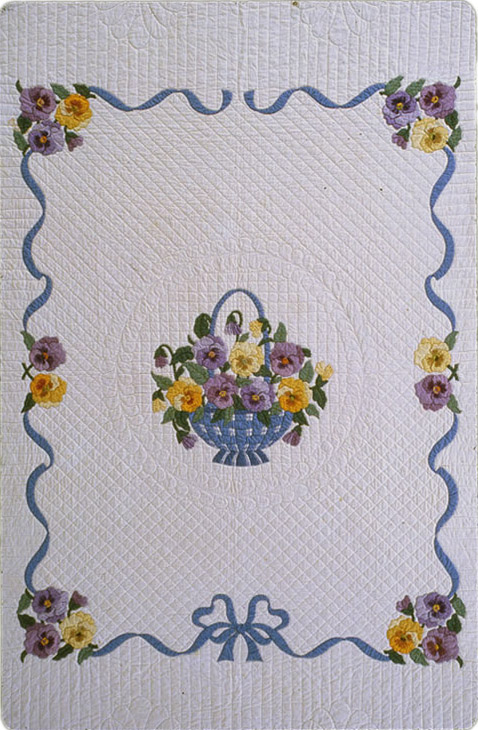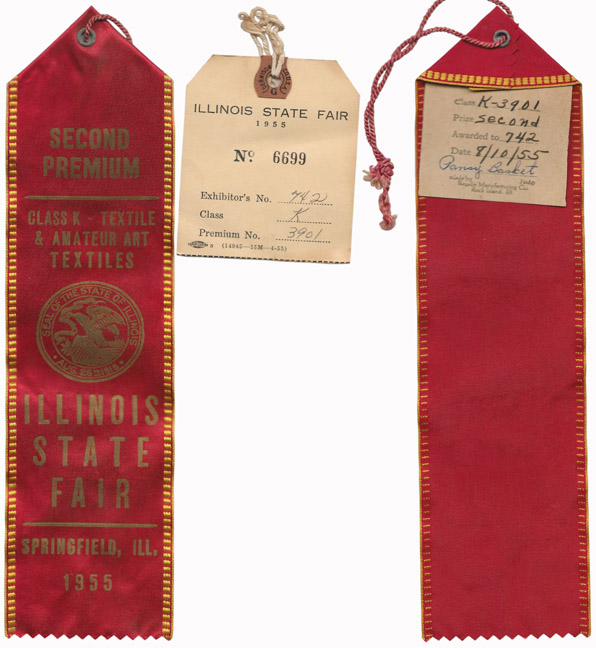
QUILT INDEX RECORD
18-14-31
Description:
Susan Salser purchased on eBay in May 2013 a quilt which is exactly like this Gasperik quilt in terms of fabrics, applique patterns and arrangement, quilting design and border, suggesting that this is another example of Gasperik using a kit to make a quilt. It is likely to be a Paragon kit, although the exact name and number of the kit are not yet known. Gasperik is known to have made at least 4 other quilts from Paragon kits: Calico Rose (Paragon kit #01082), Wild Flower Wreath (Paragon kit #01010) and 2 quilts the family calls Farmer in the Dell (Paragon kit #01013 named Farm Design Junior Quilt). Notice that the green applique border of inverted scallops is exactly the same on the Farm quilts and Pansies. The shape of the blue basket on Pansies is very similar to the shape of the vase in Calico Rose.
Essay:
This quilt may have been made from a commercial kit. It is also possible that Gasperik combined a block pattern for a pansy basket and an applique flower border design from an unknown kit. This quilt is one of the remaining Gasperik mysteries pattern source.
It looks as though this quilt was not only made from a kit, but that its quilting patterns were also determined by the kit. The quilting on this quilt does not resemble the more creative quilting seen on most Gasperik quilts. Instead, it most resembles the kind of quiltING found on another Gasperik quilt, Wild Flower Wreaths #046). Gasperik made Wild Flower Wreaths (#046) from Paragon kit No. 01010, and she followed that kit's quiltING instructions. The quiltING on Pansies and on Wild Flower Wreaths is similar (and unlike the usual Gasperik quiltING). If there existed a catalog of quilt kits offered 1935-1950 by Paragon, a New York based company, that would be a good place to look for the kit source Gasperik's Pansies quilt.
Where are the records for this quilt housed?
Mary Gasperik Legacy Project
Who documented this quilt?
Mary Gasperik Private Collection
Gasperik Legacy Project Number:
033
This is a:
Finished quilt
Quilt's title:
Pansies
Owner's name for quilt:
Pansies
Names for quilt's pattern in common use:
Basket of Pansies, Pansy Basket
How wide is the quilt?
77 inches
How long is the quilt?
86 inches
Shape of edge:
Straight
Shape of corners:
Straight
What color is the quilt?
Blue or Navy; Cream; Gold; Green; Orange; Purple; White; Yellow
Overall color scheme:
Bright or primary colors
Quilt's condition:
Excellent/like new
Time period:
1930-1949
When was the quilt finished?
1935-1945
Date estimated by an antique dealer, quilt historian or appraiser:
1935-1945
Who estimated the quilt's date?
Merikay Waldvogel
Further information concerning dates:
Estimated date is based on similar kit designs made by Bucilla in 1930s-1940s.
Describe the quilt's layout:
Medallion or framed center
Number of borders:
2
Describe the borders:
Inner border frames the basket of pansies. Inner border is a blue ribbon with pansy blooms at corners and midpoints. At the base of the ribbon is a bow knot. The outer border is a green scalloped applique to appear pieced.
Fiber types used to make the quilt top:
Cotton
Fabric styles used in the quilt top:
Solid/plain
Applique techniques used to make the quilt top:
Hand Applique
Embellishment techniques used to make the quilt top:
Embroidery
Materials used to make the back:
Cotton
What color is the back of the quilt?
White
Describe the back:
Solid/plain
Materials used in the quilt binding:
Cotton
What kind of filling is used in the quilt?
Cotton
How are the layers held together?
Hand quilting
Quilting designs used, overall motifs:
Grid diamond; Grid square; Single parallel lines
Quilting designs used, decorative motifs:
Wreaths; Other
Quilting designs used, background fills:
Grid/crosshatch
Describe the quilting designs used:
Upright bouquet of leaves (somewhat like a fleur-de-lis) are quilted at intervals around the outer edge and in the corners. A wreath encircles the central basket.
Quilt top made by:
Gasperik, Mary
Quilted by:
Gasperik, Mary
Where the quilt was made, city:
Chicago
Where the quilt was made, county:
Cook County
Where the quilt was made, state:
Illinois (IL)
Where the quilt was made, country:
United States
How was this quilt acquired?
Gift
Tell the story of how the quilt was obtained:
In 1968-69 Gasperik's daughter Elsie brought Pansies to her daughter Susan. During that same distribution of quilts as gifts to the Krueger girls from their grandmother Elsie gave Daisies Won't Tell to Susan's sister. Linda was especially fond of Pansies and asked Susan if she would trade. They exchanged quilts.
Why was the quilt made?
Personal enjoyment
The quilt was made to be used for:
Bedding, special occasion
Quilt is presently used as:
Keepsake/memento
Describe present uses of the quilt:
Mary's grandchildren regard her quilts as a unique collection to be preserved and appreciated.
Describe anything about the design of the quilt that wasn't already recorded in a previous field:
Probably a kit which has yet to be found. Bucilla 2935 "Basket of Poppies" has a similar center basket surrounded by a ribbon inner border. The Farm kit from Paragon (see Gasperik quilts #029 and #059) has a similar applique border with green scallops facing inward and a straight outside edge. It is noteworthy that the distinctive quiltING design on this quilt, a repeated Fleur-de-Lis pattern, is not seen on other Gasperik quilts, possibly indicating that Gasperik followed kit instructions, rather than her usual practice of combining quiltING designs from multiple sources.
Exhibitions where this quilt was displayed:
The Quilts of Mary Gasperik, Ravenswood Historic Site, Livermore, CA, March 14-15, 1992.
Contests entered:
Illinois State Fair, 1955, Second Place
Publications (including web sites) where this quilt or maker was featured:
Merikay Waldvogel and Barbara Brackman. Patchwork Souvenirs of the 1933 Chicago World's Fair, (Nashville, TN: Rutledge Hill Press, 1993)102-103.
Merikay Waldvogel "One American Dream Comes True", Quilters Newsletter Magazine, March 2008, 46-49.
Ownership of this quilt is:
Private
Quilt owner's name:
Linda Krueger MacLachlan
Quilt owner's country:
United States
Person filling out this form is:
Relative of quiltmaker; Author/researcher
If you are a relative of the quiltmaker, how are you related? The quiltmaker is my:
Grandmother
Describe the relationship to the quilt's maker:
Grand-daughter Susan Salser began this research effort in 1991, after she and her two sisters divided up the quilts which belonged to their mother (Elsie Gasperik Krueger) who died in 1988. Her ongoing research has been fruitful and interesting.
Quiltmaker's maiden name:
Mihalovits, Maria
Quiltmaker's gender:
Female
Quiltmaker's birth date:
01/25/1888
Quiltmaker's birthplace, country:
Hungary
Quiltmaker's date of death:
05/25/1969
Quiltmaker's ethnic background/tribal affiliation:
Hungarian
Quiltmaker's educational background:
Elementary School
In which kind of environment did the quiltmaker live?
Rural
Quiltmaker's city:
Chicago
Quiltmaker's county:
Cook
Quiltmaker's state:
Illinois (IL)
Quiltmaker's country:
United States
Quiltmaker's father's name:
Mihalovits, Istvan
Quiltmaker's father's birthplace:
Hungary
Quiltmaker's father's ethnic/tribal background:
Hungarian
Quiltmaker's mother's name:
Mihalovits, Vidoszava
Quiltmaker's mother's birthplace:
Hungary
Quiltmaker's mother's ethnic/tribal background:
Hungarian
Quiltmaker's spouse's/spouses' and/or partner's/partners' ethnic/tribal background:
Hungarian
Quiltmaker's spouse's/spouses' and/or partner's/partners' occupation:
Milk Dealer/Grocery Store Owner/Butcher
Number of children:
3
How many of the quiltmaker's children were girls?
1 (Elsie 1909-1988)
How many of the quiltmaker's children were boys?
2 (Elmer and Stephen)
How did the quiltmaker learn to quilt?
From guild or club member; Self-Taught
When did the quiltmaker learn to quilt?
Age 40-49
Why does the quiltmaker quilt?
Pleasure; Other
Other notes on how the quiltmaker learned, and how and why they quilt:
To exhibit in shows held by her Tuley Park quilt club in Chicago, the Detroit News quilt show in Detroit, many Illinois State Fairs, at least one Indiana State Fair. She entered quilts in at least 2 Chicago department store contests. She made at least one quilt and one quilt top specifically for the 1939 New York Worlds Fair quilt contest. She also made children's quilts specifically for grandchildren and great-grandchildren; and wedding and wedding anniversary quilts for her son Elmer and grand-daughter Karen. Primarily, she wanted to make quilts because it was her life passion and her greatest talent. The occasions and venues to show them presented themselves. It should be noted that prior to Mary's emigration to America in late 1904, at age 16, she was an apprenticed needleworker in her native Hungary. The intricate and colorful floral embroideries traditional to Hungary lend themselves especially well to applique, the quilt style Mary preferred.
Does/did the quiltmaker belong to a group? Name of the group?
Tuley Park Quilt Club and Detroit News Quilt Club
Does/did the quiltmaker belong to a group?
Southside Chicago and Detroit MI
What are the main activities of the group?
Chicago group met to quilt and held periodic quilt shows; Detroit group held national exhibits and contests.
Estimated number of quilts made by this quiltmaker:
more than 50
Does/did the quiltmaker sell quilts?
no
Does/did the quiltmaker teach quilting?
no
Who photographed this quilt?
Don Gonzalez
Access and copyright information:
Restricted
Copyright holder:
Hank Finn
Details
Cite this Quilt
Gasperik, Mar. Pansies. 1935-1945. From Mary Gasperik Legacy Project, Mary Gasperik Private Collection. Published in The Quilt Index, https://quiltindex.org/view/?type=fullrec&kid=18-14-31. Accessed: 04/18/24
-
Gallery
Gasperik 08: Mystery Quilts - Unidenti...
Waldvogel, Merikay
-
Exhibit
The Quilts of Mary Gasperik
Salser, Susan
-
Ephemera
The Quilts of Mary Gasperik
Salser, Susan
-
Essay
Mary Gasperik and The Illinois State F...
Salser, Susan
-
Gasperik, Mary Quiltmaker
Mary Gasperik Legacy Project

